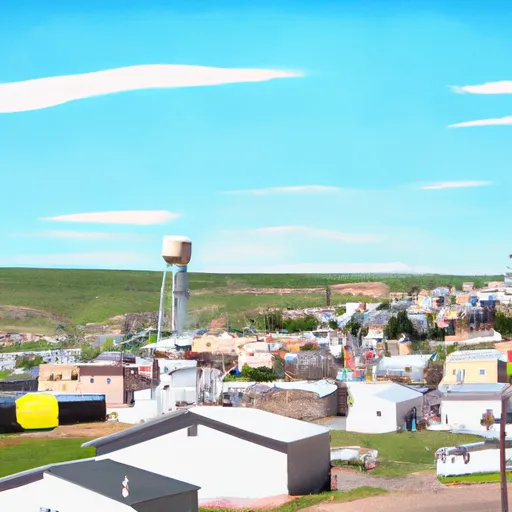-
 Snoflo Premium
Snoflo Premium
Get unlimited access to all our content
With no Ad interruptions! - Start Your Free Trial Login with existing account
Upton
Eden Index
Climate
5.6
•
Recreation
•
Community
•
Safeguard
2.3/10

Upton, Wyoming is a small town located in the northeastern part of the state. The climate in Upton is classified as semi-arid, characterized by hot summers and cold winters. Average high temperatures range from the mid-80s°F (30°C) in summer to the low 30s°F (-1°C) in winter. Precipitation is relatively low, with an average annual rainfall of about 13 inches (33 cm) and around 55 inches (140 cm) of snowfall.
Upton is situated near the Belle Fourche River, which is an important hydrological feature in the area. The river provides a source of water and supports various aquatic species, including trout. Additionally, the area around Upton has several reservoirs and lakes, offering opportunities for fishing, boating, and other water-related activities.
Outdoor enthusiasts in Upton have access to a range of recreational opportunities. The nearby Black Hills National Forest provides ample opportunities for hiking, camping, and wildlife viewing. The forest is also home to various lakes and streams, ideal for fishing and water-based activities. Additionally, Upton is close to the Thunder Basin National Grassland, offering opportunities for birdwatching, hunting, and horseback riding. With its diverse outdoor offerings, Upton is a great destination for nature lovers and those seeking an active lifestyle.
What is the Eden Index?
The Snoflo Eden Index serves as a comprehensive rating system for regions, evaluating their desirability through a holistic assessment of climate health, outdoor recreation opportunities, and natural disaster risk, acknowledging the profound impact of these factors on livability and well-being.
Climate Health Indicator (CHI): 5.6
Upton receives approximately
363mm of rain per year,
with humidity levels near 81%
and air temperatures averaging around
8°C.
Upton has a plant hardyness factor of
4, meaning
plants and agriculture in this region thrive during a short period during spring and early summer. Most
plants will die off during the colder winter months.
By considering the ideal temperature range, reliable water supplies, clean air, and stable seasonal rain or snowpacks, the Climate Health Indicator (CHI) underscores the significance of a healthy climate as the foundation for quality living.
A healthy climate is paramount for ensuring a high quality of life and livability in a region, fostering both physical well-being and environmental harmony. This can be characterized by ideal temperatures, reliable access to water supplies, clean air, and consistent seasonal rain or snowpacks.
Weather Forecast
Streamflow Conditions
Cheyenne
Area Rivers
Cheyenne
Snowpack Depths
Cheyenne
Reservoir Storage Capacity
Cheyenne
Groundwater Levels
Recreational Opportunity Index (ROI):
The Recreational Opportunity Index (ROI) recognizes the value of outdoor recreational options, such as parks, hiking trails, camping sites, and fishing spots, while acknowledging that climate plays a pivotal role in ensuring the comfort and consistency of these experiences.
Access to outdoor recreational opportunities, encompassing activities such as parks, hiking, camping, and fishing, is crucial for overall well-being, and the climate plays a pivotal role in enabling and enhancing these experiences, ensuring that individuals can engage in nature-based activities comfortably and consistently.
Camping Areas
| Campground | Campsites | Reservations | Toilets | Showers | Elevation |
|---|---|---|---|---|---|
| Keyhole State Park | 170 | 4,164 ft | |||
| Belle Fourche - Devils Tower National Monument | None | 3,860 ft |
Nearby Fishing
Nearby Ski Areas
Catastrophe Safeguard Index (CSI):
The Catastrophe Safeguard Index (CSI) recognizes that natural disaster risk, encompassing floods, fires, hurricanes, and tornadoes, can drastically affect safety and the overall appeal of an area.
The level of natural disaster risk in a region significantly affects safety and the overall livability, with climate change amplifying these risks by potentially increasing the frequency and intensity of events like floods, fires, hurricanes, and tornadoes, thereby posing substantial challenges to community resilience and well-being.
Community Resilience Indicator (CRI):
The Community Resilience Indicator (CRI) recognizes that education, healthcare, and socioeconomics are crucial to the well-being of a region. The CRI acknowledges the profound impact of these elements on residents' overall quality of life. By evaluating educational resources, healthcare accessibility, and economic inclusivity, the index captures the essential aspects that contribute to a thriving community, fostering resident satisfaction, equity, and social cohesion.

